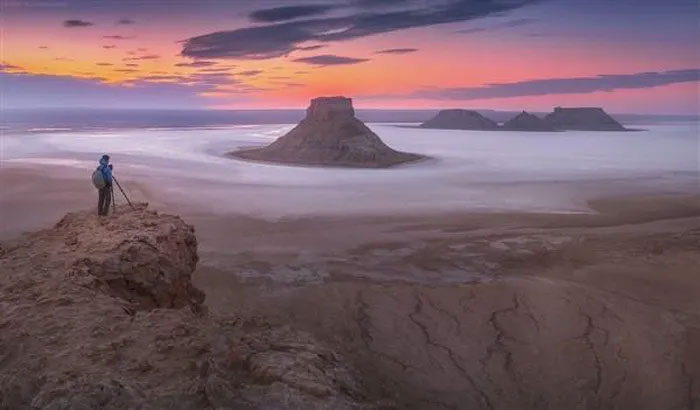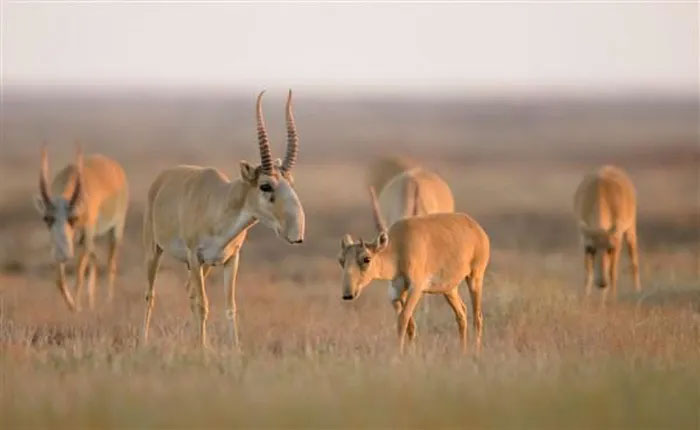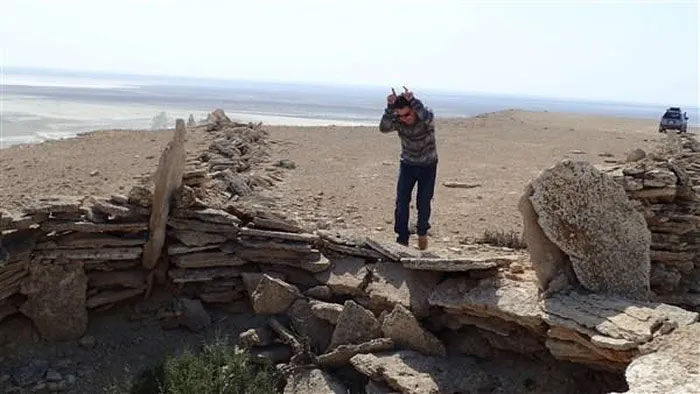Ustyurt is located in Central Asia, spanning Kazakhstan, Uzbekistan, and Turkmenistan. The annual rainfall here is only 120mm, with extreme temperatures ranging from 40oC to minus 40oC, making it unsuitable for human habitation.
However, in Ustyurt, a series of ancient relics appear, resembling long and wide walls. Viewed from above, they resemble the shape of a kite.
Stunning Salt Desert

Ustyurt is desolate yet stunning.
Ustyurt covers an area of 200,000 km2, with an average elevation of 150m and its highest point reaching 370m. It is situated between the Caspian Sea and the Aral Sea, making it an extremely remote and barren land.
Approximately 21 million years ago, Ustyurt was submerged under the Tethys Sea (an ancient ocean that formed the present-day Black, Aral, and Caspian Seas). Geological activity gradually pushed it upwards, leaving behind a thick layer of salt.
Over tens of millions of years, the surface of Ustyurt has been shaped by weathering. Limestone cliffs emerge, eroded into bizarre formations. Beneath them, enormous salt deposits and shallow lakes appear.
In summer, temperatures in Ustyurt can reach 40oC. The scorching sun burns the ground, leaving the salt surface dry and blindingly white. In the early morning, Ustyurt resembles a sea of sparkling salt crystals, vibrant and beautiful. Under the sunset, it takes on an enchanting red hue.
On the chalky white slopes, bones, shark teeth, shells, and marine fossils are scattered. In the clay-rich areas, the landscape of Ustyurt consists of rust-colored barren hills. While not as magnificent as the salt mountains, they possess their own unique charm.
In winter, temperatures in Ustyurt can drop to -42oC. Despite the harsh cold, its landscape remains breathtaking.
The “Desert Kites”

The desert kites likely served as traps for catching wild ungulates.
The annual rainfall in Ustyurt is only 120 mm. With its salt surface and extremely low humidity, it is unsuitable for plant growth, except for a few “survival experts” like cacti, sagebrush, and saltgrass.
Despite spanning three countries, Ustyurt is home to only a few nomadic tribes that have chosen it as their livelihood. In 1920, while flying over the Middle East, British and French military pilots witnessed an astonishing sight below.
It was a series of magnificent structures, consisting of two or more rows of large stones leading to a giant stone circle. From above, they resemble arrows and kites, aptly named Desert Kites.
In 1952, Russian archaeologist and ethnographer Sergey Tolstov visited Ustyurt and witnessed the “desert kites” firsthand, dating them. He reported that they were over 2,000 years old and constructed from local stone.
For the Middle East, the “desert kites” are familiar ancient structures. They are scattered throughout the Levant, Saudi Arabia, Armenia, Yemen, and are estimated to number around 5,800.
The sizes of individual “desert kites” vary, but their construction method is similar. They are made from earth and stones piled high. Archaeologists speculate that “desert kites” served as residences or enclosures for livestock.
Animal Traps?

The remains of the “desert kites” are scattered throughout Ustyurt.
The “desert kites” of Ustyurt feature stone perimeters that extend from half a mile or more (over 0.8 km). Many sections of the perimeter have collapsed, with broken stones mixed with surrounding rocks and disappearing. Most of the remaining sections are only about 30 cm high.
After examining several “kites”, Tolstov found that some were still in use until the mid-20th century. However, they were not used for habitation or livestock confinement, but rather as animal traps.
The Ustyurt Plateau lies along the migration route of many Central Asian wild animals such as donkeys, sheep, and gazelles. At the end of summer, they surge through areas filled with “kites.”
According to Tolstov, in ancient times, Ustyurt was also a grazing area for nomadic tribes. Ancient residents intentionally stacked stones into structures with pathways and enclosures, herding ungulates into them for capture.
At the very least, Ustyurt has been a favored hunting ground for local nomads from the Iron Age until the early 20th century. About 25 years ago, Ustyurt still saw tens of thousands of saiga antelopes passing through.
“Initially, hunters did not overhunt but only took enough to eat,” said archaeologist Andrey Astafyev (Kazakhstan). The wildlife of Ustyurt only deteriorated after the 1990s, during the collapse of the Soviet Union, which heavily impacted Central Asia. Many workers fell into unemployment and turned to hunting (especially saiga antelope horns) and smuggling for survival.
Today, Ustyurt has tightened conservation efforts. In the Ustyurt Nature Reserve in Kazakhstan, nearly 300 species of flora and fauna are strictly protected.
Recently, Kazakhstan has collaborated with Uzbekistan to actively save the saiga antelope, which is on the brink of extinction. The “desert kites” are no longer used and continue to crumble. Even those that remain intact trap nothing but the sun and wind of the steppe.


















































